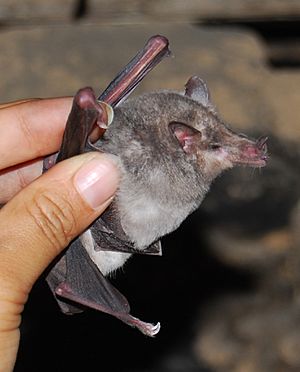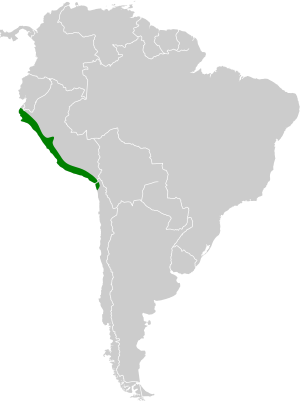Long-snouted bat facts for kids
Quick facts for kids Long-snouted bat |
|
|---|---|
 |
|
| Conservation status | |
| Scientific classification | |
| Genus: |
Platalina
|
| Species: |
genovensium
|
 |
|
The long-snouted bat (Platalina genovensium) is a special type of bat. It belongs to the Phyllostomidae family. This bat is the only species in its group, called Platalina. You can only find it in northern Peru and northern Chile. It mostly eats the sweet nectar and fruit from tall, columnar cactus plants. This bat is rare, but it lives in many different places. There are at least 25 known groups of these bats. It is listed as "near-threatened" because its home is being destroyed. This means its main food source is disappearing.
Contents
Description of the Long-Snouted Bat
Long-snouted bats are usually about 7.2 to 8.9 centimeters (about 3 inches) long. Their tail is very short, only 0.5 to 1.1 centimeters. Their forearm, which is part of their wing, can be from 12.8 to 26.5 centimeters long. These bats typically weigh between 12.8 and 26.5 grams. A pregnant female might be at the higher end of this weight range.
A typical long-snouted bat is about 81 millimeters long. Its wings can spread out to 341 millimeters. It usually weighs around 19.5 to 19.9 grams. This bat has the largest wing area of any known glossophagine bat. This helps it fly easily, especially at high altitudes. It is also the biggest bat in its family, Lonchophyllinae. Its large size might help it stay warm when night temperatures drop close to freezing.
This bat is known for its very long nose, called a muzzle. This long muzzle suggests it is very good at finding certain foods. It also has a long, stretchy tongue covered in tiny bumps. These bumps help it collect nectar. Its front teeth are wide and spoon-shaped. It has a diamond-shaped nose-leaf on its face. The skin between its legs, called the interfemoral membrane, is long and has little hair. Its tail sticks out about one-third of the way into this membrane. The bat's body is light brown. The base of each hair is lighter than the tip. Its belly is also lighter than its back.
Where the Long-Snouted Bat Lives
The long-snouted bat lives on the western side of the Andes mountains. You can find it from Piura in the north to Tacna in the south of Peru. Most studies about this bat have happened near Arequipa. On the eastern side of the Andes, only one group has been found near Huánuco.
These bats live at different heights, from sea level up to 2,500 meters (about 8,200 feet). However, no bat has been found below 2,200 meters. These bats are strongly linked to desert areas. These deserts must have many tall, columnar cactus plants. Scientists think that where these bats live might change with rainfall. During El Niño events, when there is more rain, they might move to wetter areas.
Habitat and Roosting Places
The long-snouted bat needs a specific type of plant to live. It needs many Weberbauerocereus cacti, especially W. weberbaueri. There should be about 20 to 30 of these cacti in an area of 100 square meters. The amount of fruit, pollen, and nectar these cacti produce limits how many bats can live there. This means that during dry periods, the bat population can change a lot.
These bats usually live in groups of up to 50 individuals. Sometimes, they might split into smaller groups of 5 to 7 bats within their roost. These groups can include only males or a mix of males and females. No groups of only females have been found. All known groups of long-snouted bats live in old, abandoned mines.
Diet of the Long-Snouted Bat
The long-snouted bat has a very special relationship with the W. weberbaueri cactus. They help each other in a process called mutualism. The bat is the main pollinator for this cactus. This means it helps the cactus make seeds and fruit. The bat also helps spread the cactus seeds. This type of cactus produces fruit all year, even after many months without rain. This allows a small number of bats to survive.
When the long-snouted bat pollinates the cactus, it helps the cactus produce more fruit. The success rate goes from 40% to 77%. This means more food is available in the ecosystem for other animals like rodents and birds. During and after dry periods, two types of hummingbirds also help pollinate the cactus. These are the Platagona gigas and Rhodopis vesper hummingbirds.
The bats also eat a few small beetles found inside the flowers. However, the main part of their diet is cactus pollen. Scientists have studied the bats' diet using a special method. They found that the long-snouted bat almost only eats plants that use a special type of photosynthesis called CAM. Or, they eat insects that feed on these CAM plants. Other plants that might be part of their diet include Browningia candelaris and Neoraimondia arequipensis. The number of bats an area can support changes. During rainy years, there might be 5 bats per hectare. In dry years, there might be only 0.5 bats per hectare. The bats are most active around 8 p.m.
Reproduction and Life Cycle
During very dry periods, long-snouted bats might stop reproducing completely. This could happen because fertilization is delayed. In 1993, scientists found that 3 out of 8 adult female bats were pregnant or nursing in October. This suggests that the main breeding time is around October. This time matches when the cacti start flowering in spring. Pregnant females have also been found in September, March, and June. We don't know how long pregnancy or nursing lasts for these bats. Females might have slightly longer forearms than males, which is called sexual dimorphism.
Conservation Status
The long-snouted bat faces several threats. The main problems are losing their habitat and being collected for traditional medicine. Because they live in small numbers and depend on columnar cacti, they are very sensitive to habitat loss. Also, their roosting places in old mines make them easy targets for collectors. If bats are collected during dry times, when populations are low and they are not reproducing, it could really harm local groups of bats.
In local cultures, bats are sometimes used for traditional medicine. People believe they can help with problems like epilepsy or heart attacks. Another threat is that El Niño events, which cause droughts, might happen more often due to climate change. The number of long-snouted bats is going down. Their population has decreased by 10 to 30% over 10 years. The long-snouted bat is one of only two bat species listed as "critically endangered" by Peruvian law. The International Union for Conservation of Nature (IUCN) also lists it as "near threatened."
See also
 In Spanish: Murciélago longirrostro peruano para niños
In Spanish: Murciélago longirrostro peruano para niños


